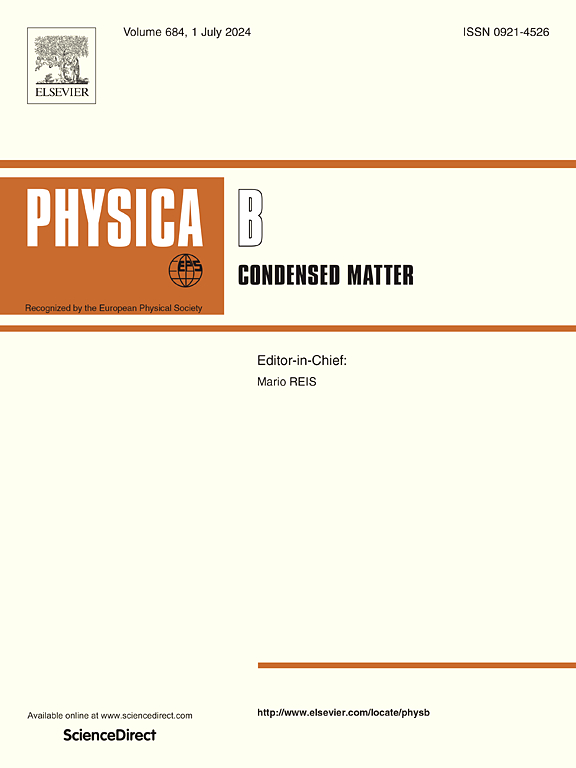合成纳米姜黄素共轭二氧化钛生物纳米复合材料,用于增强光学、电学和抗菌应用
IF 2.8
3区 物理与天体物理
Q2 PHYSICS, CONDENSED MATTER
引用次数: 0
摘要
本研究通过简单的无溶剂机械混合,探讨了纳米姜黄素(NCur)的合成及其对二氧化钛(TiO2)结构、电学和抗菌性能的影响。FTIR证实了NC-TiO2的相互作用,而UV-Vis光谱显示了红移,带隙从3.571 eV减小到2.550 eV。XRD证实了TiO2的晶体保留。光学显微镜和FE-SEM的形态学分析表明,NCur在TiO2中的分散均匀,达到6 wt%,超过6 wt%会发生团聚。电阻抗研究表明,在100 Hz时,电导率增加了1.127倍,在6 wt% NCur时,活化能从5.37 × 10 - 5eV降低到5.00 × 10 - 5。此外,介电常数提高了29%,增强了材料的储能潜力。抑菌实验表明,TiO2/NCur生物纳米复合材料对大肠杆菌具有显著的抑菌活性,抑菌效果提高了183.33%。这些多功能特性使得TiO2/NCur复合材料在生物安全电子、储能和抗菌技术方面的应用前景非常广阔。本文章由计算机程序翻译,如有差异,请以英文原文为准。
Synthesis of nanocurcumin conjugated titanium dioxide bio-nanocomposites for enhanced optical, electrical, and antibacterial applications
This study explores the synthesis of nanocurcumin (NCur) and its impact on the structural, electrical, and antibacterial properties of titanium dioxide (TiO2) through a simple solvent-free mechanical mixing. FTIR confirmed NC-TiO2 interactions, while UV–Vis spectroscopy showed a red shift and a reduced bandgap from 3.571 eV to 2.550 eV. XRD verified the crystalline retention of TiO2. Morphological analysis using optical microscopy and FE-SEM showed uniform NCur dispersion in TiO2 up to 6 wt%, beyond which agglomeration occurred. Electrical impedance studies demonstrated a 1.127-fold increase in conductivity at 100 Hz and a reduction in activation energy from 5.37 × 10−5eV to 5.00 × 10−5 at 6 wt% NCur. Additionally, the dielectric constant increased by 29 %, enhancing the material's energy storage potential. Antibacterial assays indicated that TiO2/NCur bio-nanocomposites exhibited significant antibacterial activity against E. coli, increasing efficacy by 183.33 %. These multifunctional properties make TiO2/NCur composites highly promising for applications in biosafe electronics, energy storage, and antibacterial technologies.
求助全文
通过发布文献求助,成功后即可免费获取论文全文。
去求助
来源期刊

Physica B-condensed Matter
物理-物理:凝聚态物理
CiteScore
4.90
自引率
7.10%
发文量
703
审稿时长
44 days
期刊介绍:
Physica B: Condensed Matter comprises all condensed matter and material physics that involve theoretical, computational and experimental work.
Papers should contain further developments and a proper discussion on the physics of experimental or theoretical results in one of the following areas:
-Magnetism
-Materials physics
-Nanostructures and nanomaterials
-Optics and optical materials
-Quantum materials
-Semiconductors
-Strongly correlated systems
-Superconductivity
-Surfaces and interfaces
 求助内容:
求助内容: 应助结果提醒方式:
应助结果提醒方式:


